You can live comfortably in Italy on a modest budget — often 30%–70% cheaper than the U.S. — if you pick smaller cities or rural areas; Rome and Milan cost more. Expect one-bedroom rents from about €350 in small towns to €1,150–€1,400 in big cities; groceries and dining are affordable, and public transit is cheap. Utilities and healthcare add modest monthly costs. Keep this in mind, and you’ll find practical tips and regional breakdowns ahead.
Housing: Rent, Buying and Regional Differences
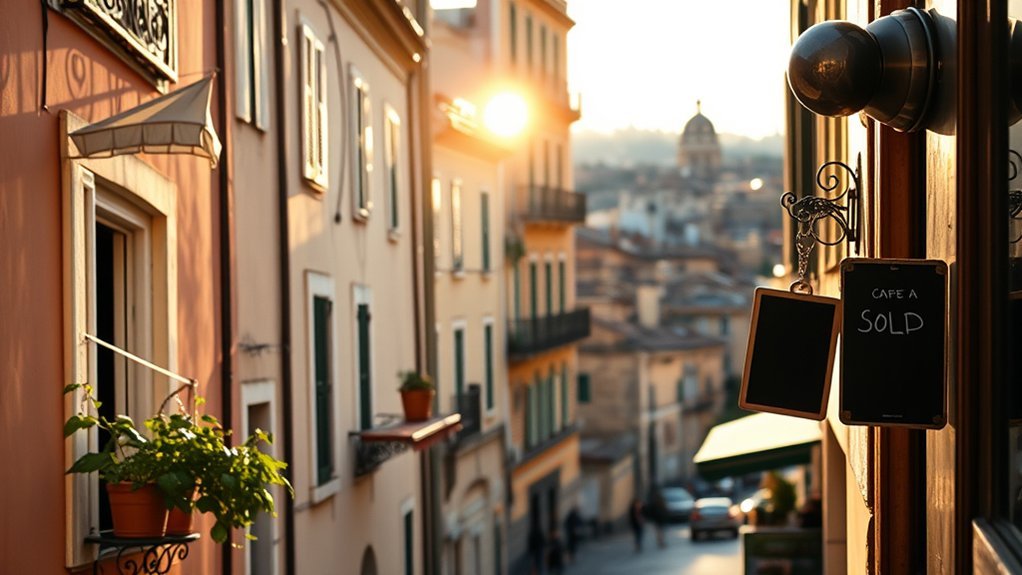
Although prices vary a lot between cities and the countryside, you’ll quickly notice rent and purchase costs reflect whether you want urban convenience or rural savings.
Prices swing sharply between city convenience and countryside savings, so choose location wisely when comparing rent and purchase.
If you move to Italy seeking city life, expect rent for a one-bedroom in Rome or Milan around $1,150–$1,400; in smaller towns like Lecce or Rieti you can find one-bedrooms for €350–€430 or, in Rieti, an 800 sq ft two-bed for about €420.
Buying follows a similar split: fixer-uppers in rural areas often go for €45,000–€50,000, while new or refurbished properties start near €250,000.
Furnished options demand a premium — think €600/month for a 750 sq ft condo on Terminillo.
Keep regional differences and the average cost of living in mind: mortgages are often limited by age (rare past 75), so many buyers pay cash, especially at lower prices.
Balance your priorities — space, location, and budget — when comparing housing, rent, and buying across Italy.
Food and Dining: Groceries, Restaurants and Saving Tips
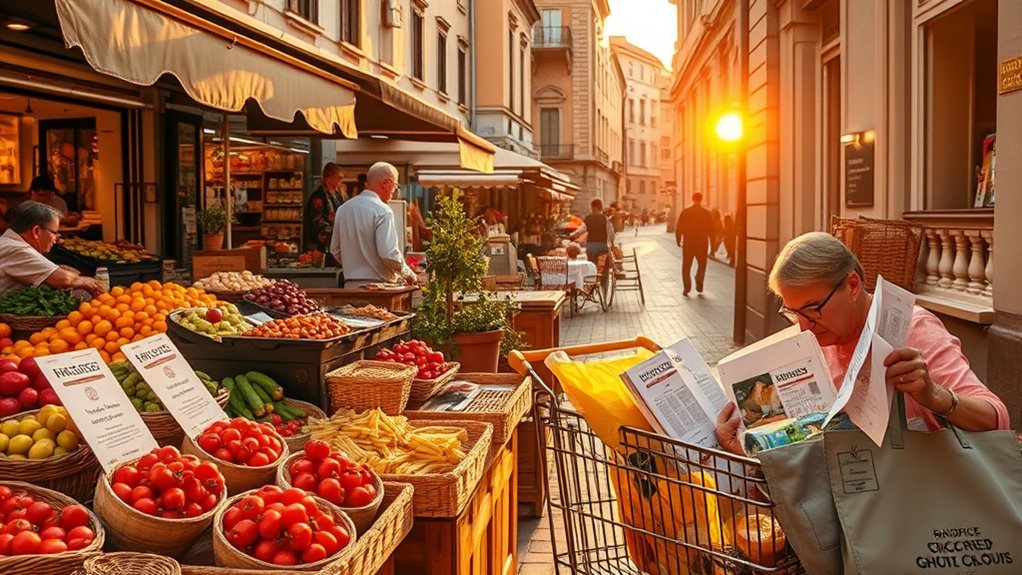
If you want to keep food costs reasonable without sacrificing quality, aim for locally produced staples and shop smart. You’ll find typical monthly grocery bills around €600 for healthier choices, with roughly 90% sourced locally in rural areas.
Everyday grocery prices — Special K Granola €3.19, six local eggs €2.75, lean ground beef €4.76/lb — help you compare value across stores. Dining out is flexible: a pizza slice can be about $1, while a restaurant meal usually runs €15–€50 per person. Takeout for a group averages €70 (≈€17.50 each), so weigh convenience against grocery cooking.
Use these practical saving tips:
- Get store savings cards, coupons, and shop promotions to trim grocery expenses.
- Build relationships with local markets for fresher, cheaper seasonal produce.
- Cook staples in bulk and freeze portions to reduce per-meal costs.
You’ll balance dining pleasure and modest costs by combining smart shopping with occasional restaurant treats.
Transportation: Public Transit, Cars and Monthly Costs
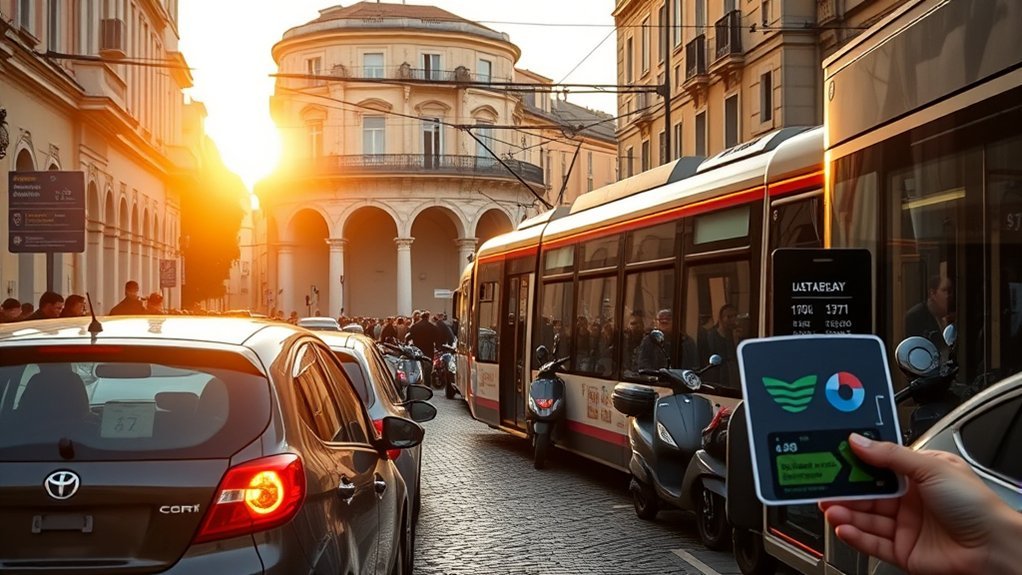
After you’ve balanced grocery shopping and occasional restaurant meals, you’ll want to think about how you’ll get around—your choices can change your monthly budget as much as your eating habits.
Public transport in Italy is affordable: local bus trips are cheap and longer train rides (Rome–Naples round trips ≈ €26) are reasonable. If you commute daily, a monthly public transportation pass in cities like Rome typically costs €32–€40, which often beats driving when you tally monthly costs.
Owning a car raises transportation expenses: expect about $298/month covering fuel, taxes and basic car maintenance, with fuel around $7.41–$9.05/gal. Minor repairs can be as low as €10 and annual maintenance averages about $150, so maintenance itself stays modest.
Taxis are regulated and convenient for short hops. Weigh convenience against cost: commuters who value flexibility might accept car expenses, while those prioritizing savings will find public transport the most affordable, predictable option.
Utilities, Home Energy and Monthly Bills
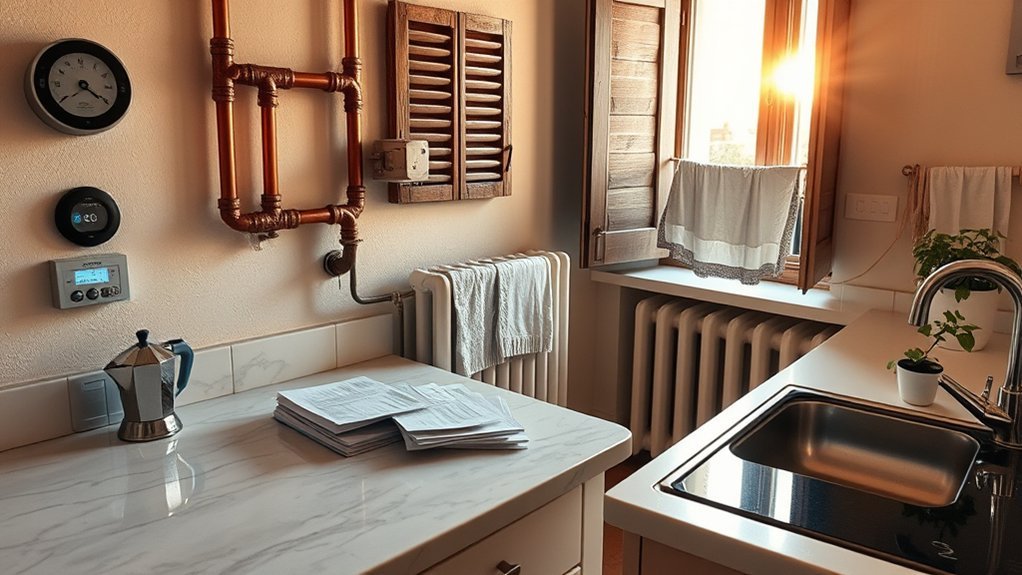
When you budget for living in Italy, utilities and home-energy costs can shift your monthly spending as much as rent does, so it’s worth understanding the breakdown:
You’ll typically see total utilities around $804 monthly, which bundles internet, phone, TV, heat, electricity costs, water expenses and gas expenses.
Electricity alone runs about $246; gas and water are roughly $79 and $150 respectively. Basic utility bills (heat, electricity, water) often fall between $150–$190 depending on consumption and location.
Choose heating options wisely — electricity, gas, wood, pellets, or solar — since they drive big swings in costs.
Choose your heating method carefully—electricity, gas, wood, pellets, or solar—as it greatly affects your energy bills.
For example, a cord of wood is about $120 per season; pellets average $2,242 for 210 bags (around $187/month).
- Expect variability by region and building efficiency
- Compare electricity costs vs. pellet/wood heating seasonally
- Factor internet/phone/TV into your monthly bills total
Being practical about heating options and consumption helps you control overall utilities and home energy spending.
Healthcare, Insurance and Other Living Expenses
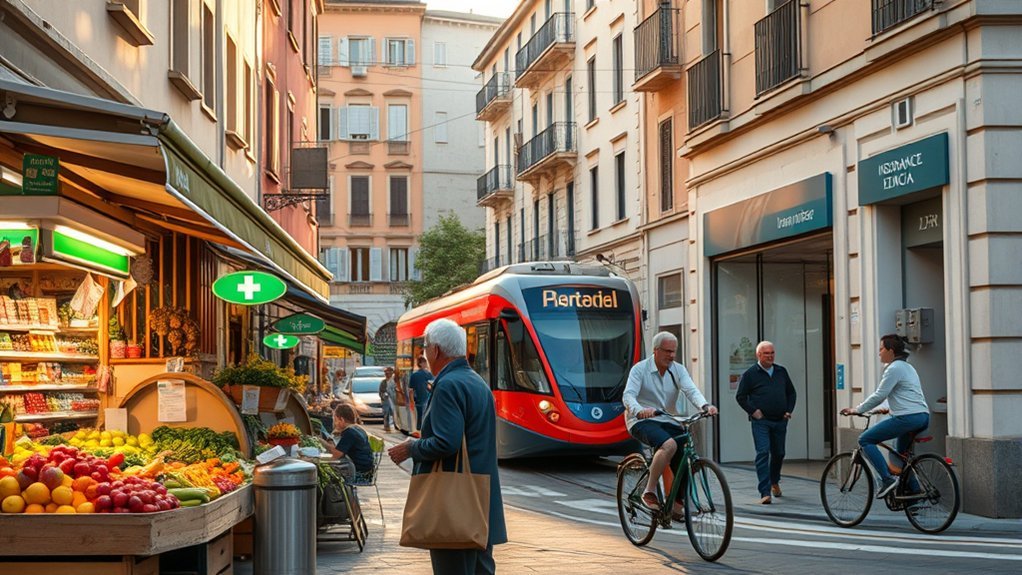
Utilities and home-energy choices affect more than your monthly bills — they free up room in your budget for health care and other day-to-day expenses.
Once you’ve lived in Italy six months and got your Permesso di Soggiorno and Carta d’Identità, you can join the National Health system. The annual cost of Italian nationwide health insurance runs about €748 for two people, far lower than many U.S. plans.
You’ll still pay out-of-pocket prescription costs — roughly €600 a year — which contributes to about $135 monthly in medical spending.
When you plan living expenses, factor healthcare into the total living expenses figure: couples average around $3,500 per month including housing and everyday costs.
Costs in Italy tend to be 30%–70% lower than in the U.S., especially outside big cities. You’ll find the healthcare system accessible and affordable, but regional differences mean your exact premiums and services will vary by province, age, and income.
Frequently Asked Questions
Is It Cheaper to Live in Italy Than the US?
Yes — you’ll usually pay less in Italy; cost comparison shows lower grocery prices, healthcare expenses, utility bills and often transportation costs, though lifestyle differences, dining out and cultural experiences can raise expenses depending where and how you live.
Can a US Citizen Live in Italy?
Yes — you can live in Italy. Remember my friend who navigated small-town bureaucracy like a maze? You’ll handle Visa requirements, Residency permits, Healthcare access, Language barriers, Cultural differences, Employment opportunities, Cost of living, and Social integration with preparation and patience.
How Much Is Rent in Italy?
Rent in Italy varies: you’ll see rent prices from about $350–$1,400 depending on apartment types and city differences. Consider utility costs, housing markets, lease agreements, neighborhood amenities, and follow rental tips to compare options effectively.
Is It Easy to Live in Italy as a Foreigner?
Like learning to sail, you’ll adapt: language barriers and cultural differences challenge you, but visa requirements and job opportunities vary, healthcare access and transportation options help, local cuisine and social integration make living in Italy rewarding.
Conclusion
Living in Italy can be affordable or pricey depending on where you settle — think Naples versus Milan. You’ll save on healthcare and public transit compared with many places, but rent and utilities vary regionally. For example, Maria, a teacher in Bologna, pays €650 rent, uses buses and enjoys local markets to cut food costs. Weigh housing, transport and lifestyle choices to match your budget and desired quality of life before you move.


